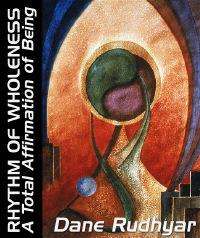 |
| Home | Bio | Art | Music | Literature | Civilization & Culture | Philosophy of Wholeness | Theosophy & Spirituality | Astrology |

RHYTHM OF WHOLENESS A Total Affirmation of Being by Dane Rudhyar, 1983 CONTENTS PROLOGUE PART ONE The Philosophy of Operative Wholeness 1. Prelude to a New Interpretation of Reality 2. The Search for Spiritual Security: The One, the Whole, and Wholeness 3. The Movement of Wholeness PART TWO The Cycle of Being 4. The Structure of the Cycle of Being 5. The Four Crucial Phases of the Cycle of Being 6. The Inevitability of Success and Failure 7. Spirit and Mind PART THREE The Cycle of Man 8. Constitution of Man - The Physical and Psychic Bodies 9. Constitution of Man - The Spiritual Entity and the Higher Mind 10. The Structure and Transformation of the Total Person 11. The Cyclic Process of Spiritual Embodiment PART FOUR In The Spirit of Wholeness 12. The Principle of Holarchy and the Interplay of Horizontal and Vertical Relationships 13. Transpersonal Activity versus Mediumship 14. Rites of Passage Page 1 Page 2 Page 3 EPILOGUE |

CHAPTER FOURTEEN
Rites of Passage - 3 "The Path" as a rite of passage The Path is, I believe, most significantly and constructively understood as a long and arduous rite of passage. The now popularized concept of a series of four or five "great Initiations," which is derived from Buddhist as well as from Masonic traditions, refers to crucial moments of this ritual process at which successive levels of Pleroma power and consciousness are brought to a focus in the individual treading the Path of total and irrevocable transformation. The whole process is a rite because the factors structuring it have a universal or rather planetary validity; they refer to the archetype of Man and what is generically possible to a member of the species homo sapiens. The form of the rite nevertheless is colored by the culture and religion of the individual undertaking the transformative process. The form is also affected by the responses that can be expected of an individual whose sub-conscious motivations have been conditioned since birth (or even before) by a particular set of early family patterns and religious assumptions which are extremely difficult, though necessary, to overcome. The Path of radical transformation implies a vertical relationship between centers of consciousness and activity at two levels, between the person treading the Path and one (or more) Pleroma beings. The spiritual power of the planetary level becomes focused through the "Master" (the Pleroma being), for the purpose of assisting the "disciple," insofar as assistance is possible and safe. A more or less definite mode of communication may be established, normally involving prayer or meditation at the personal level and a concrete or symbolic, direct or indirect, answer from the Pleroma level. The human being's tendency to personalize the relationship and personify its spiritual pole is unavoidable in most instances and in a sense justifiable; yet it can cause the disciple to misinterpret and give an overly concrete, literal form to the products of a relationship which seems to take a personal form only because it is interpreted by a disciple still functioning in a very personal way. Much depends upon the exact level at which the individual center of the disciple's being is able normally, or under abnormal pressures, to operate — thus on his or her quality of will, purity of motives, and capacity of mind to picture the ritual process of transformation. The resilience and strength of the body are also very important, for a release of spiritual power would easily shatter a weak or unprepared organism. At the level of the collective psychism of the disciple's culture responsible for the structure of his or her mind, it also could arouse forces always ready to oppose any individually determined and effective ascent toward the Pleroma — the spiritual all-human community. Such an opposition has been dramatized in "occult" novels and assuredly can be a powerful factor setting limits to what any individual on the Path can hope to accomplish in his or her present life span. However, these limits should be considered manifestations of the individual's karma, thus of the legacy he or she received at conception from previous cycles of existence, either recent or long past. In addition to personal karma, collective racial and sociocultural karma also is involved, for both the individual and collective polarities of human existence inevitably are activated in any determined effort to radically transform the fundamental nature of mankind at any particular stage of planetary evolution. Just as the level of evolution of mankind affects the possibilities open to any particular person, so the success (or failure) of any one individual consciously entering the Path affects to some degree the entire evolutionary process on earth. The situation can be understood more clearly by referring the Path, as a process of transformation, to the great cycle of being outlined in Part One of this book. The possibility of beginning this process can arise only in an individualized, conscious, determined, and relatively independent or self-induced manner at a particular stage of the evolutionary curve. This must occur somewhere past the midpoint between the symbolic Noon and Sunset, for such a midpoint symbolizes the definite beginning of the process of individualization. If ultimately successful, the process leads to the stage of Illumined Man, the Gate of Silence at which the principles of Unity and Multiplicity are of equal power and the human consciousness is illumined by the light, power, and presence of the creative God (the symbolic Sunrise or "first point" of a particular cosmic cycle). Strictly speaking, the "human" phase of the great cycle of being is consummated in Illumined Man; what human beings experience as objective existence passes into an increasingly subjective state of "inistence" leading to the Godhead state at which the principle of Unity attains its maximum value for the particular cosmic cycle. As discussed in Part Three, what is rather inaccurately called "reincarnation" is actually the development of a relationship between a single spiritual Quality (one of the myriad Letters of the creative Word-in-the-beginning, or Logos) and a series of successive earth-born human beings developing within successive cultures. Such a series of increasingly individualized persons becomes gradually more attuned and responsive to the spiritual Quality seeking to find a perfect vehicle of expression in a human form and thus -to consummate the "divine Marriage" of spirit and matter. The process of radical transformation called the Path begins when one of the personalities of this series becomes aware in an individualized and self-induced manner that it is connected with a spiritual Quality — in whatever way his or her religion, philosophy, and culture names it and explains its existence — and completely accepts union with it as an essential, ideal goal. A particular person may not accomplish much toward this goal, but efforts made in that direction are not lost; they strengthen the subtle connecting link between the spiritual Quality and any new person drawn to the series. Every positive and successful step counts; every moment of crucial weakness, indecision, or collapse delays advance on the Path. Progress can be so delayed that the planetary cycle of mankind ends before the supreme moment of union occurs, in which case the process will have to begin again in another great cycle, and probably at about the same point at which the decisive delay previously took place. From the point of view of Wholeness, nothing can ever be lost, except the possibility for a particular participant in a cycle to experience Wholeness in that particular cycle. If one thinks of the reason for the formation of a new universe, it is the loss of such a possibility which generates a new time. Many years ago I wrote, "Time is God's compassion for chaos." The polarization of God and chaos (or of Unity and Multiplicity, which has much the same philosophical meaning at the level of abstract principles) implies either time or an absolute dualism denied by the very fact of thinking about it; for the thinker evidently is neither God nor chaos but part of a movement of relatedness between these opposites. This dynamic process of relationship is the Movement of Wholeness. Every whole in the universe, be it an atom, a galaxy, or a human being, is a phase of that movement. When a human being enters the Path, the movement accelerates. It takes the form of a ritual because every movement, every act, becomes symbolic. It becomes a mythos which must be lived by every person on the Path. It is a walk, a series of falls and recoveries. Each individual must tread it alone, yet his or her whole culture also is involved, for the culture has molded the individual's mind. The Pleroma, too, is involved, because the future includes the past whence the Pleroma has emerged through dynamic but always uncertain and dangerous presents. Whoever does the walking must carry the burden of time and causation, must experience the birthing of the future out of the womb of the past through individualized nows. The individualization of time — of the meaning a person gives to a series of events, once he or she has started on the Path of transformation of the basic frames of reference to which these events are to be related — is indeed an unrelenting necessity. So, at least, it must seem to the traveler on the Path. Yet perhaps as one comes very close to the supreme moment of Illumination, this too may seem to be an illusion produced by an unbalanced relation between Unity and Multiplicity — between "I" and the universe. As the Gate of Silence is reached and the opposite polarities of being are perfectly equilibrated for an instant, does not Wholeness reveal itself as changelessly perfect and whole? Is it "for an instant" only? Are transitions and rites of passage, from self-limiting levels to always more inclusive ones, never ending? Is even the continuum of change the ultimate illusion? Or does the supreme realization arise only when one totally accepts the fact that Motion is unceasing, that Wholeness is a tidal movement of being; and that peace and fulfillment can come only to the consciousness that has identified itself with that movement, whatever form its turning points and reversals of polarity may take? For such a consciousness every moment sings with a rapture of change and unceasing renewal. By permission of Leyla Rudhyar Hill Copyright © 1983 by Dane Rudhyar All Rights Reserved.  Web design and all data, text and graphics appearing on this site are protected by US and International Copyright and are not to be reproduced, distributed, circulated, offered for sale, or given away, in any form, by any means, electronic or conventional. See Notices for full copyright statement and conditions of use. Web design copyright © 2000-2004 by Michael R. Meyer. All Rights Reserved. |
 |